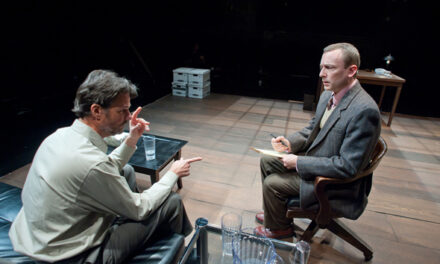The American Dance Festival marked the beginning of its 32nd year in Durham, and 76th year overall, with its first performance in the recently-opened Durham Performing Arts Center (DPAC), which is replacing Duke University’s Page Auditorium as the larger of the two performance venues the ADF uses each season. Appropriately, the program was an ADF-commissioned premiere, eagerly anticipated, of the final part of Shen Wei’s Re-, a trilogy of reconsiderations made since a period of intensive traveling and working in Asia, after 14 years in New York.
Re- (Part III) derives from Shen Wei’s travels along the route of China’s ancient Silk Road, west from Beijing for 40 days, to the border with Tajikistan, and his later return to Beijing to work on the opening ceremonies for the 2008 Olympics there. A sense of vastness seems to have entered Shen Wei’s work since these travels. In the Olympic ceremony he was able to express it with thousands of bodies in a tremendous hall, but in Re- (Part III), made for an ordinary theater, he communicates the great spaces by means of repeated rhythmic marches across the stage by wheeling groups of dancers.
One of the great strengths of this company is the dancers’ integration with each other, so that they can breathe and move as one organism. It is not that each gesture or position is precisely the same in all the dancers — nothing so contrived; it is that the postures and changes are executed in the same breath by all that makes them seem inevitable and necessary to the viewer. As the dancers travel on and on, they sometimes make themselves into arches and bridges and camels (in a rather Pilobolean maneuver). The flow is the thing; it is driven ceaselessly onward by the beat of David Lang’s music (commissioned for the work and performed by Todd Reynolds, violin). Together, sound and movement work some kind of alchemy that converts the stage into an almost limitless plain, and minutes into months of time spent gazing outward, toward the far horizon.
Re- (Part I) comes next on the program. Here in Durham we’ve had the opportunity to see this piece develop since its 2006 premiere. It was performed in a revised version in January and has been renovated a little more now. Shen Wei removed the overt religious symbols which had been included in January’s mandala and has reverted to the simpler, blue and white design used in the original but shaped to fit the larger stage. That is a big improvement. The dancing is gentler, more serene, and it finally feels like this piece is finished.
Certainly it fits easily and well, with a mineral coolness, between (Part III) with its animal force, ancient beat, and brash modernity, and (Part II), with its more sinuous knotting and flow, and its almost vegetative spirit. (Part II) is also the show-stopper of the three dances so, theatrically speaking, it makes sense to put it last.
Shen Wei set this piece originally on Les Grands Ballets Canadiens and began putting it on his company in January, during a residency at Duke. It uses imagery, experiences and feelings from Ankor Wat, and it is very beautiful — perhaps the most beautiful piece he’s made since Near the Terrace. It has some of the same visual banding across the stage’s picture plane and some of the same slow elegance, but it is more fecund. It is also more sculptural, and it takes full advantage of the sinuous bodies of these dancers who know stillness as well as they know motion. Of the three dances, I was most moved by this one, but none of them is enough on its own. These three disparate expressions of his experience and thought must be performed together for us to grasp the magnitude of Shen Wei’s larger art.
Shen Wei continues at the DPac through June 20. See our calendar for details.











